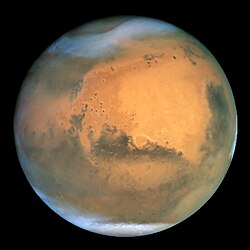Seznam kaňonů na Marsu
Seznam kaňonů na Marsu je doplňující materiál pro Seznam údolí na Marsu. Kaňon je hluboká deprese s příkrými stěnami odpovídající tomu samému termínu na Zemi.
| Jméno | Souřadnice[1] | Poznámky |
|---|---|---|
| Arsia Chasmata | 7.5S, 119.4W | |
| Ascraeus Chasmata | 8.7N, 105.7W | |
| Australe Sulci | 84.9S, 135E | |
| Baetis Chasma | 4.3S, 65W | |
| Candor Chasma | 6.5S, 70.9W | Část Valles Marineris |
| Capri Chasma | 9.8S, 43.3W | |
| Ceti Chasma | 5S, 68.4W | |
| Chasma Australe | 82.2S, 94.4E | |
| Chasma Boreale | 82.9N, 47.1W | |
| Coprates Chasma | 13.2S, 61.4W | Část Valles Marineris |
| Echus Chasma | 2.6N, 80.1W | |
| Elysium Chasma | 22.3N, 141.5E | |
| Eos Chasma | 12S, 39.7W | Část Valles Marineris |
| Ganges Chasma | 7.9S, 48.1W | Část Valles Marineris |
| Hebes Chasma | 1.1S, 76.2W | |
| Hellas Chasma | 34.6S, 294.5W | |
| Hyblaeus Chasma | 22N, 141.2E | |
| Ius Chasma | 6.9S, 85.8W | Část Valles Marineris |
| Juventae Chasma | 3.5S, 61.4W | |
| Melas Chasma | 10.3S, 72.7W | Část Valles Marineris |
| Ophir Chasma | 4S, 72.5W | Část Valles Marineris |
| Pavonis Chasma | 2.7N, 111.2W | |
| Promethei Chasma | 82.2S, 141.5E | |
| Tithonium Chasma | 4.6S, 84.7W | Část Valles Marineris |
| Ultimum Chasma | 81.2S,151.1E |
Reference
- ↑ Dle Google - Mars
Související články
Externí odkazy
 Obrázky, zvuky či videa k tématu Seznam kaňonů na Marsu na Wikimedia Commons
Obrázky, zvuky či videa k tématu Seznam kaňonů na Marsu na Wikimedia Commons - lanetarynames.wr.usgs.gov
Média použitá na této stránce
NASA's Hubble Space Telescope took the picture of Mars on June 26, 2001, when Mars was approximately 68 million kilometers (43 million miles) from Earth — the closest Mars has ever been to Earth since 1988. Hubble can see details as small as 16 kilometers (10 miles) across. The colors have been carefully balanced to give a realistic view of Mars' hues as they might appear through a telescope. Especially striking is the large amount of seasonal dust storm activity seen in this image. One large storm system is churning high above the northern polar cap (top of image), and a smaller dust storm cloud can be seen nearby. Another large dust storm is spilling out of the giant Hellas impact basin in the Southern Hemisphere (lower right).
